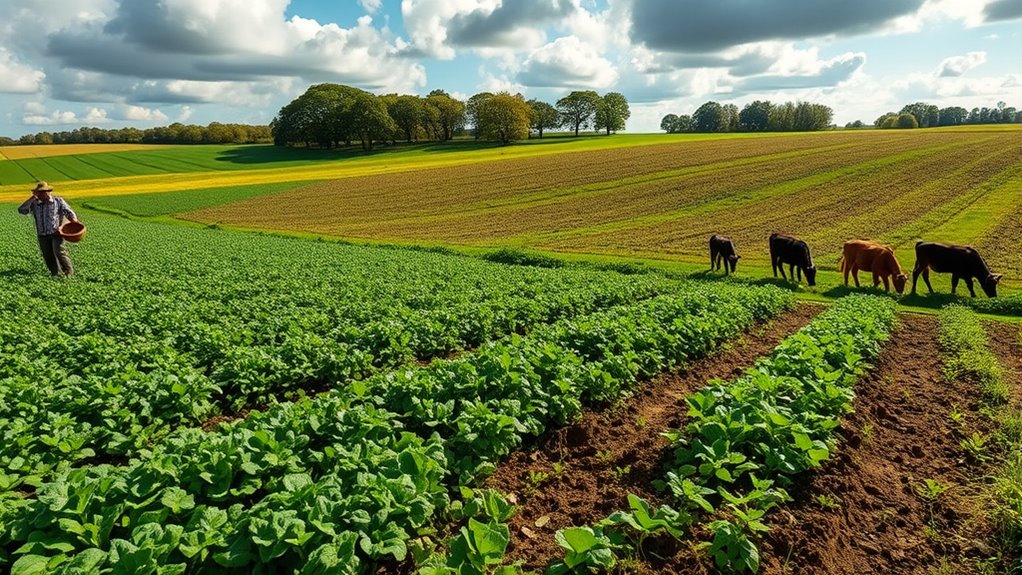Regenerative agriculture focuses on restoring soil health, increasing biodiversity, and improving ecosystem resilience through practices like cover cropping, minimal disturbance, and organic matter addition. It encourages crop diversity, sustainable grazing, and water conservation to build healthy soils and support microbial communities. Using local seed varieties and engaging communities are also key. By adopting these principles, you can create more sustainable and productive land. Continue exploring to discover how these practices work together for lasting results.
Key Takeaways
- Regenerative agriculture focuses on restoring soil health through practices like cover cropping, minimal tillage, and organic matter addition.
- It emphasizes enhancing microbial diversity to improve soil resilience, nutrient cycling, and ecosystem stability.
- Incorporating crop rotation, polyculture, and agroforestry promotes plant diversity and long-term productivity.
- Livestock management and controlled grazing support soil fertility and prevent overgrazing.
- Community engagement and sustainable practices aim to reduce chemical inputs and build resilient, self-sustaining farming systems.
Cover Cropping and Plant Diversity

Have you ever wondered how farmers improve soil health naturally? One key method is using cover cropping and plant diversity. By planting cover crops like clover or vetch, you protect the soil from erosion, especially during off-season times when rain can wash away nutrients. These crops also act as natural pest management tools, reducing the need for chemicals by attracting beneficial insects and disrupting pest cycles. Diverse plantings create a resilient soil ecosystem, enhancing nutrient cycling and improving soil structure. This approach minimizes disturbance, keeps the soil covered, and fosters a thriving environment for microorganisms. Additionally, integrating cover crops can contribute to long-term soil fertility, which is essential for sustainable agriculture and crop productivity. Proper soil management practices are vital for maintaining healthy soils and maximizing the benefits of cover cropping. Incorporating proper storage techniques ensures the preservation of seed quality and effectiveness of cover crops in future planting seasons. Implementing data-driven strategies can help farmers optimize cover crop selections and planting schedules for better results. Understanding the role of microorganisms is crucial, as they play a vital part in breaking down organic matter and releasing nutrients into the soil. Overall, cover cropping and plant diversity are crucial strategies that promote healthy, productive soils while reducing environmental impact.
Minimal Soil Disturbance and No-Till Practices

By maintaining diverse cover crops and healthy soil ecosystems, you can reduce the need for intensive tillage that disrupts soil structure. No-till practices preserve soil aeration, which is essential for root growth and microbial activity. Soil health plays a crucial role in sustainable agriculture and long-term productivity. Tillage impact can lead to soil compaction and erosion, harming long-term fertility. Instead, you use tools like planters that minimize disturbance, maintaining the integrity of soil aggregates. This approach promotes natural soil regeneration and reduces erosion risks. High critical acclaim and box office success. Here’s a quick comparison:
| Aspect | Traditional Tillage | No-Till Practices | Benefits |
|---|---|---|---|
| Soil Aeration | Disrupted by Tillage | Preserved naturally | Healthier roots, microbes |
| Tillage Impact | Causes compaction, erosion | Minimal disturbance | Enhanced soil structure |
| Soil Fertility | Depletes organic matter | Maintained through cover crops | Sustainable productivity |
Adopting minimal soil disturbance supports resilient, healthy soils and fosters soil microbial diversity, which is vital for nutrient cycling and overall soil vitality. Additionally, cover cropping can further improve soil resilience by providing continuous ground cover that protects against erosion and enhances organic matter content. Incorporating minimal disturbance techniques can also help in reducing carbon emissions associated with conventional tillage practices.
Composting and Organic Matter Enhancement
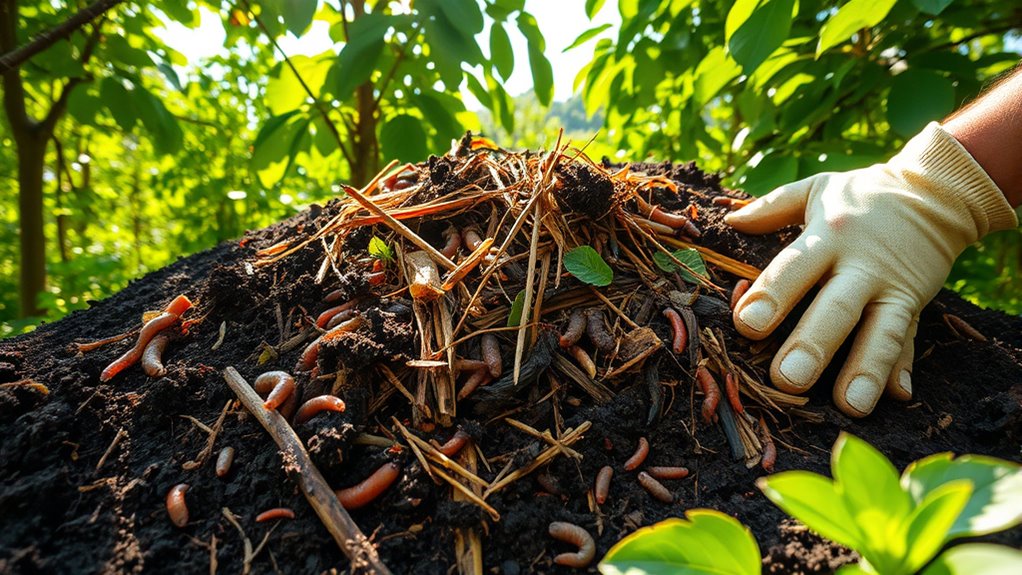
Enhancing soil organic matter through composting is a vital step in building healthy, resilient soils. When you add compost, you increase soil carbon, which improves soil structure and water retention. This process also boosts nutrient cycling by providing a steady release of essential nutrients, making them more available to plants. Composting transforms organic waste into a rich, dark humus that feeds soil microbes, fostering a thriving soil ecosystem. As microbes break down organic matter, they release nutrients in forms plants can absorb easily. Regular compost application helps maintain a stable level of organic matter, preventing soil degradation. Additionally, supporting soil health contributes to overall ecosystem resilience and sustainable farming practices. By focusing on composting and organic matter enhancement, you support long-term soil health, increase crop productivity, and reduce reliance on synthetic fertilizers, aligning with regenerative agriculture principles. Incorporating soil microbiology practices further enhances the breakdown of organic matter and nutrient availability, strengthening soil vitality. Furthermore, understanding microbial activity in soils helps optimize composting processes for better nutrient release and soil fertility. A comprehensive approach that considers soil microbial diversity can lead to more effective and sustainable soil management strategies. Moreover, integrating organic matter management strategies can significantly improve soil resilience against erosion and climate stressors.
Integrating Livestock and Grazing Management
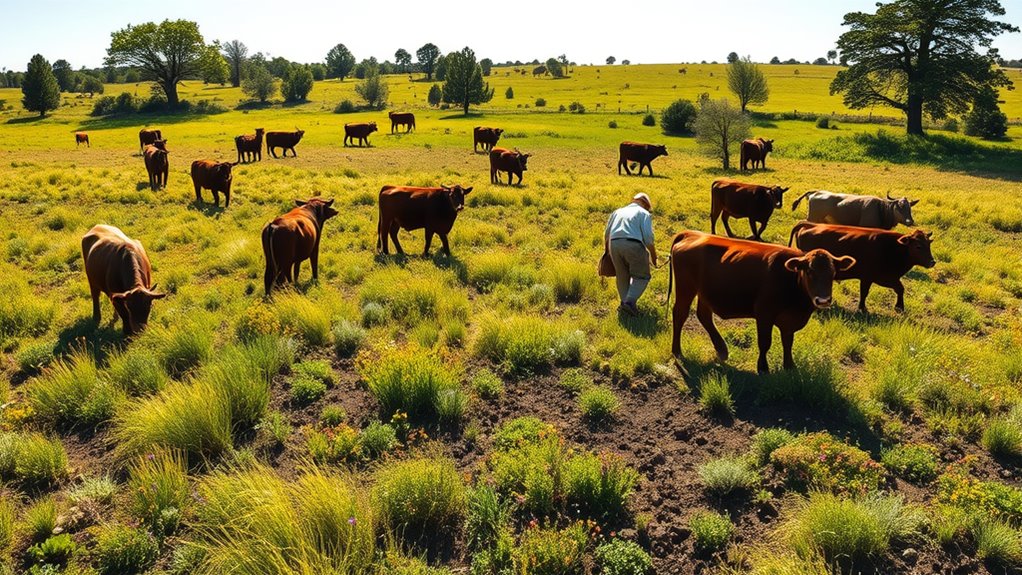
You can improve soil health and plant growth by using effective grazing rotation strategies that prevent overgrazing. Livestock substantially influence soil fertility and structure when managed properly, enhancing the land’s regenerative ability. By optimizing stocking rates, you ensure your pasture remains productive while supporting sustainable livestock integration. Additionally, implementing proper climate control techniques can help maintain optimal conditions for pasture growth and livestock health. Employing practices that support soil health can further amplify these benefits, as healthy soil enhances water retention and nutrient cycling, contributing to overall ecosystem resilience. Incorporating organic and natural juices into your land management practices can also promote plant vitality and microbial activity, supporting a thriving regenerative system. Moreover, utilizing antioxidants found in natural plant compounds can boost plant resilience against environmental stressors, further supporting ecosystem stability. Recognizing the role of microbial activity in soil health can help optimize organic inputs and foster a balanced soil ecosystem.
Grazing Rotation Strategies
Implementing effective grazing rotation strategies involves carefully managing the movement of livestock to optimize pasture health and productivity. Properly timed rotations prevent overgrazing, promote soil health, and enhance livestock integration. When you rotate livestock efficiently, you give pastures time to recover, increase plant diversity, and improve nutrient cycling. This approach reduces soil erosion and builds resilient ecosystems. To maximize benefits, consider these key practices:
- Adjust grazing periods based on plant growth stages
- Use portable fencing for flexible pasture divisions
- Monitor pasture conditions regularly
- Incorporate rest periods for grazed areas
- Align livestock density with pasture capacity
- Incorporating portable fencing can facilitate flexible and efficient pasture management.
Livestock Impact on Soil
Livestock have a direct and significant influence on soil health, shaping the physical, chemical, and biological properties of the land. Through livestock grazing, animals help control plant growth, stimulate root development, and promote nutrient cycling. Proper manure management ensures that manure is evenly distributed, enriching the soil with essential nutrients and organic matter. This process reduces the need for synthetic fertilizers and supports soil microbial activity. Grazing patterns, when well-managed, prevent overgrazing and soil compaction, maintaining soil structure and porosity. Additionally, manure adds crucial nutrients like nitrogen and phosphorus, boosting soil fertility. By integrating thoughtful grazing practices and manure management, you can enhance soil health, increase carbon sequestration, and foster a resilient ecosystem that sustains both your land and livestock. Understanding how soil microbial activity is affected by these practices is essential for optimizing soil regeneration and long-term productivity, especially as healthy microbes play a key role in soil nutrient cycling.
Stocking Rate Optimization
Optimizing stocking rates is crucial for balancing livestock numbers with the land’s capacity to support them. Properly managed stocking rates enhance soil fertility and improve pasture management, creating a resilient ecosystem. When you adjust stocking rates, you prevent overgrazing, allowing plants to recover and maintain ground cover. This supports better soil health and reduces erosion. Key strategies include monitoring pasture growth, using rotational grazing, and adjusting livestock numbers seasonally. By integrating livestock and grazing management, you can increase productivity while restoring soil vitality. Recognizing signs of over- or under-stocking, and adapt accordingly, is essential for sustainable land use. Effective stocking rate management leads to healthier soil, abundant forage, and sustainable land use. Additionally, understanding raw food principles can help optimize the nutritional intake of livestock, contributing to overall farm health and productivity. Incorporating animal behavior insights can further improve grazing efficiency and ensure the health of your herd.
Crop Rotation and Polyculture Systems

Crop rotation and polyculture systems are essential strategies in regenerative agriculture that enhance soil health, reduce pests, and increase crop resilience. By rotating crops, you prevent soil erosion and break pest and disease cycles, keeping your soil productive and healthy. Polyculture systems diversify plant species in your fields, creating a natural barrier against pests and reducing the need for chemical interventions. These practices promote balanced nutrient cycling, improve soil structure, and foster beneficial microorganisms. When you implement crop rotation and polycultures, you’re actively reducing the risk of soil degradation and fostering a resilient farming system. This approach not only supports sustainable yields but also protects your land’s long-term productivity, making your farm more resilient to environmental stresses.
Agroforestry and Tree Incorporation
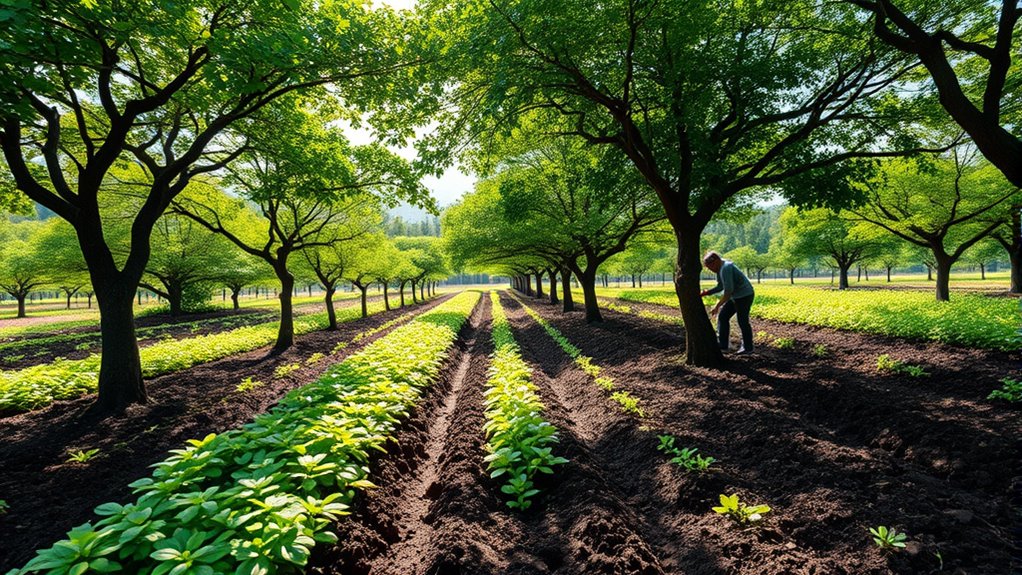
Incorporating trees into your farm offers multiple benefits, such as improving soil health, increasing biodiversity, and providing additional income streams. To maximize these advantages, you need to design agroforestry systems that suit your land’s specific conditions and goals. By understanding how to effectively integrate trees, you can create a more resilient and productive landscape.
Benefits of Tree Integration
Have you ever considered how adding trees to your agricultural land can transform your farm’s productivity and sustainability? Integrating trees offers numerous benefits, including improved soil health, enhanced biodiversity, and better water retention. Trees provide shade, which helps regulate soil temperature and reduces evaporation, benefiting crops and livestock alike. Regular tree pruning encourages healthy growth and maximizes canopy coverage. Additionally, trees act as windbreaks, reducing erosion and protecting your crops. The integration of trees also creates habitats for beneficial insects and birds, boosting pest control naturally. Overall, incorporating trees into your farm promotes resilience, reduces input costs, and supports long-term productivity, making your operation more sustainable and environmentally friendly.
- Boosts soil health and fertility
- Provides essential shade for crops and animals
- Reduces wind erosion with windbreaks
- Encourages biodiversity and natural pest control
- Supports sustainable water management
Designing Agroforestry Systems
Designing effective agroforestry systems involves carefully selecting and arranging trees to maximize their benefits while harmonizing with your existing land use. By thoughtfully integrating trees, you can reduce soil erosion, improve soil health, and enhance pest management naturally. It’s essential to contemplate tree placement, species selection, and their interaction with crops. Proper design creates a balanced system that fosters biodiversity and resilience. Use the following table to visualize different components:
| Feature | Benefits |
|---|---|
| Windbreaks | Reduce soil erosion, protect crops from wind damage |
| Shade trees | Suppress pests, conserve soil moisture |
| Companion trees | Improve soil fertility, attract beneficial insects |
With strategic planning, your agroforestry system becomes a crucial tool for sustainable farming.
Water Conservation and Management Techniques
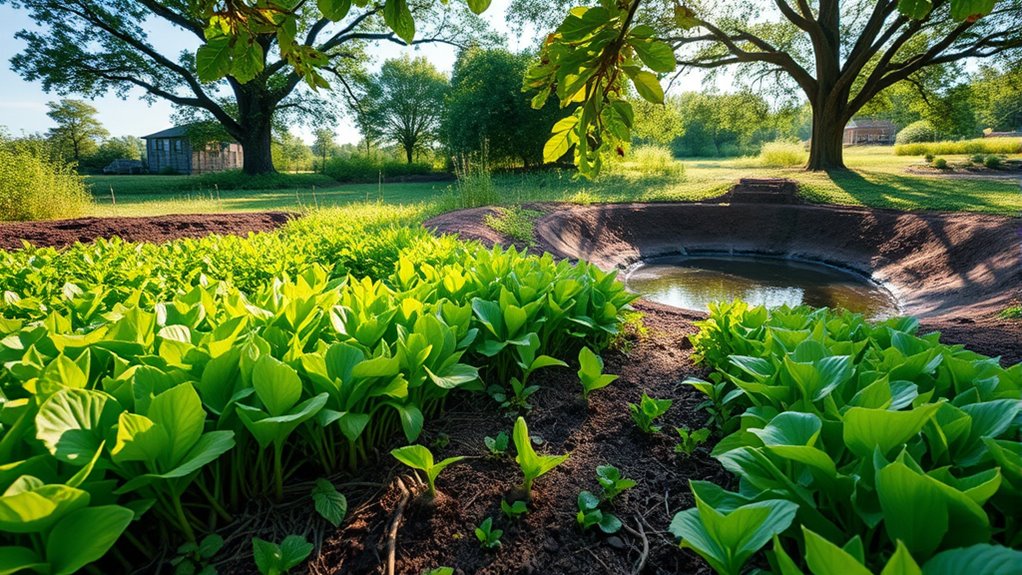
Effective water conservation and management are essential to support sustainable agriculture and protect natural resources. You can maximize water use efficiency by implementing techniques like rainwater harvesting, which captures and stores rainfall for later use. Improving soil moisture retention helps reduce irrigation needs and keeps plants healthy during dry periods. Mulching around crops minimizes evaporation and maintains soil humidity. Drip irrigation delivers water directly to plant roots, reducing waste. Additionally, creating contour beds or swales helps slow runoff and promotes water infiltration. These methods not only conserve water but also enhance soil health and resilience.
- Use rainwater harvesting systems to collect and store rainfall
- Apply mulch to conserve soil moisture
- Install drip irrigation for targeted watering
- Create contour beds to slow runoff
- Practice cover cropping to improve water retention
Building Soil Microbial Communities
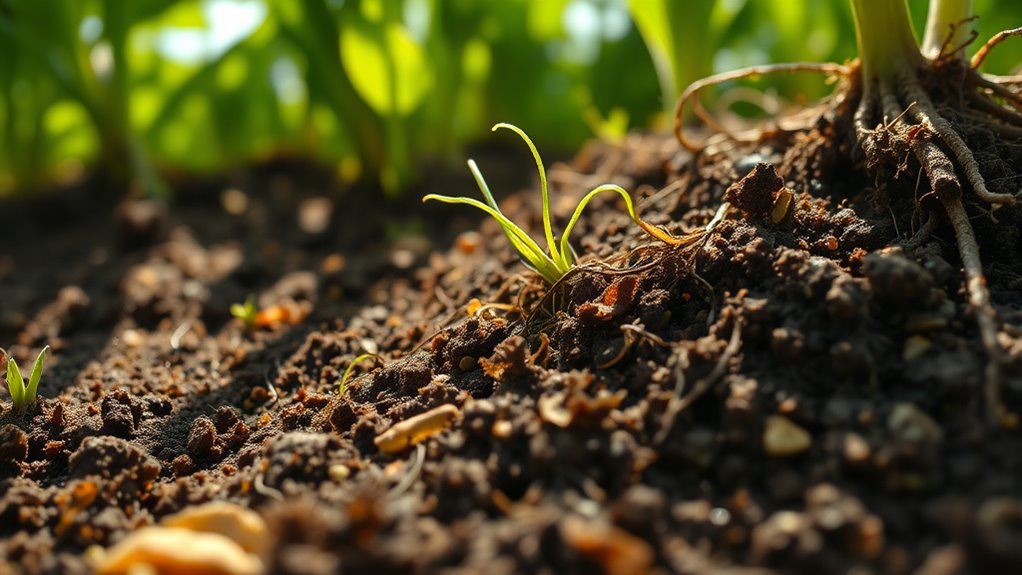
Building healthy soil microbial communities boosts plant growth and resilience by increasing microbial diversity. Adding organic matter and planting cover crops provides essential food sources for these microbes to thrive. Together, these practices create a vibrant, active soil ecosystem that supports sustainable farming.
Microbial Diversity Benefits
Have you ever wondered how diverse soil microbes enhance agricultural resilience? A rich microbial community boosts soil health through increased soil enzyme activity and complex microbial network interactions. This diversity helps break down organic matter more efficiently, releasing essential nutrients for plants. It also suppresses harmful pathogens by outcompeting them, reducing the need for chemical inputs. Additionally, diverse microbes improve soil structure, increasing water retention and drainage. By fostering microbial variety, you create a resilient system that adapts to environmental stresses.
- Boosts nutrient cycling efficiency
- Strengthens plant immune responses
- Enhances soil stability and aeration
- Promotes sustainable crop yields
- Supports long-term soil vitality
Organic Matter Enhancement
Ever wondered how adding organic matter can transform soil into a thriving microbial habitat? When you incorporate organic amendments, you boost soil carbon levels, providing essential energy for microbes. This enhances soil microbial communities, leading to healthier soil structure and nutrient cycling. To understand this better, consider the table below:
| Organic Amendment | Benefits for Soil Microbes | Impact on Soil Health |
|---|---|---|
| Compost | Rich in nutrients | Improves fertility |
| Cover Crop Residues | Adds organic matter | Boosts microbial diversity |
| Manure | Provides organic carbon | Enhances soil structure |
| Crop Waste | Supplies organic amendments | Promotes microbial activity |
| Biochar | Stabilizes soil carbon | Improves moisture retention |
Cover Crops Role
Did you know that cover crops play a crucial role in enhancing soil microbial communities? By choosing the right cover crops, you support beneficial microbes that improve soil health and nutrient cycling. These microbes help with pest management by suppressing harmful organisms naturally. Proper crop selection encourages diverse microbial populations, which strengthen plant resilience. Cover crops also provide food for microbes, increasing their activity and diversity. This boosts soil structure and fertility, reducing the need for synthetic inputs. Additionally, cover crops can break pest cycles and shield crops from weeds. Incorporating legumes or grasses as cover crops creates a balanced environment, promoting healthy microbial ecosystems. Overall, strategic crop selection and cover crop management are essential for building robust soil microbial communities.
Emphasizing Local and Resilient Seed Varieties

Since seed selection is fundamental to resilient farming systems, prioritizing local and hardy varieties becomes essential. By focusing on seed sovereignty, you support farmers’ rights to save, exchange, and grow their own seeds, fostering independence from industrial suppliers. Local adaptation ensures that seed varieties are well-suited to your specific climate, soil, and ecological conditions, increasing their chances of thriving and resisting pests or diseases. Choosing resilient local seeds reduces dependence on external inputs, enhances biodiversity, and strengthens the farm’s overall stability. This approach encourages a diverse seed bank tailored to your environment, promoting sustainability and long-term productivity. Emphasizing local and resilient seed varieties aligns with regenerative principles, helping to restore natural ecosystems and build a more resilient agricultural system.
Community Engagement and Knowledge Sharing
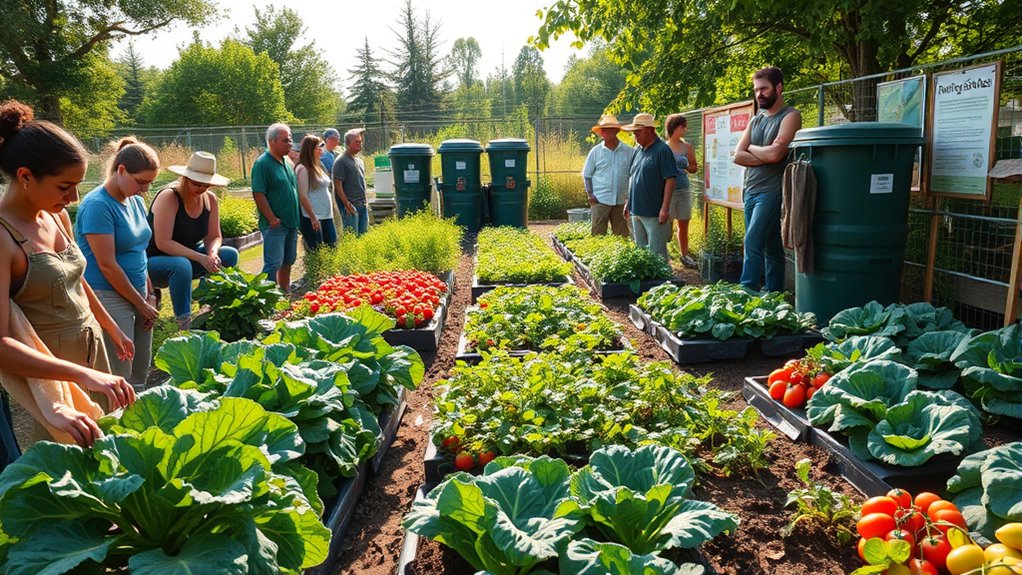
Building strong community connections enhances the success of regenerative agriculture by fostering shared knowledge and collective resilience. When you engage with local groups, you can exchange tips on urban gardening, such as using compost tea to boost soil health. Sharing experiences helps everyone improve practices and adapt to challenges together. Community events like workshops or farm visits create opportunities for learning and collaboration. You might organize compost tea brewing demos or urban gardening projects that inspire others. These connections also encourage collective problem-solving and support local food systems. By actively participating, you help build a network that sustains regenerative principles and spreads innovative ideas. Strengthening community ties ensures a more resilient, informed, and motivated movement toward sustainable agriculture.
- Organize local compost tea workshops
- Share urban gardening successes
- Create online knowledge exchanges
- Host farm-to-table events
- Collaborate on community projects
Frequently Asked Questions
How Do Regenerative Practices Impact Long-Term Farm Profitability?
You’ll find that regenerative practices boost your long-term farm profitability by improving soil health, which enhances crop yields and resilience. Incorporating crop diversity reduces pest and disease risks, lowering input costs. Over time, healthier soil and diverse crops lead to more sustainable production, decreasing reliance on external inputs. This holistic approach not only safeguards your farm’s profitability but also promotes environmental stewardship, ensuring your farm remains productive and profitable for generations.
What Are Common Challenges in Transitioning to Regenerative Agriculture?
When shifting to regenerative agriculture, you’ll face challenges like improving soil health and increasing crop diversity. These shifts require time, effort, and sometimes initial financial investment. You might encounter resistance from traditional practices or struggle with learning new techniques. However, focusing on building healthy soil and diversifying crops can boost resilience and productivity in the long run. Staying patient and adaptable will help you overcome these common hurdles effectively.
How Can Small-Scale Farmers Adopt These Principles Affordably?
You can adopt regenerative agriculture principles affordably by focusing on improving soil health and increasing crop diversity. Start small with low-cost practices like composting, cover cropping, and crop rotation. These methods boost soil vigor and reduce input costs. Collaborate with nearby farmers to share resources and knowledge. By gradually integrating these techniques, you’ll see sustainable benefits without significant upfront investments, making regenerative farming accessible for small-scale farmers.
What Role Does Policy Play in Promoting Regenerative Agriculture?
Policy plays a vital role in promoting regenerative agriculture by offering policy incentives that encourage sustainable practices. You benefit when governments support farmer education programs, helping you learn and implement regenerative methods effectively. These policies can reduce costs, improve access to resources, and foster community collaboration. When policymakers prioritize regenerative agriculture, you’re more likely to adopt eco-friendly techniques, ensuring healthier soil, better yields, and long-term sustainability for your farm.
How Can Consumers Support Regenerative Farming Initiatives?
Think of your choices as a garden of influence. By choosing products that support regenerative farming, you’re watering soil carbon and encouraging crop diversity. Your support acts like sunlight, helping farmers implement sustainable practices. Opt for local, organic, or regenerative-certified foods. Share their stories, too. Every meal becomes a seed of change, nurturing healthier soils and resilient farms. Your support is the key to cultivating a future where agriculture and nature thrive together.
Conclusion
By embracing these regenerative agriculture principles, you’re nurturing the soil like a delicate garden, turning it into a thriving tapestry of life. Each step you take rebuilds the land, fostering resilience and sustainability for generations to come. Your efforts aren’t just farming—they’re planting hope and healing into the earth’s heart. Together, you’re creating a legacy that blooms with vigor, proving that caring for the land is truly cultivating a better future.
